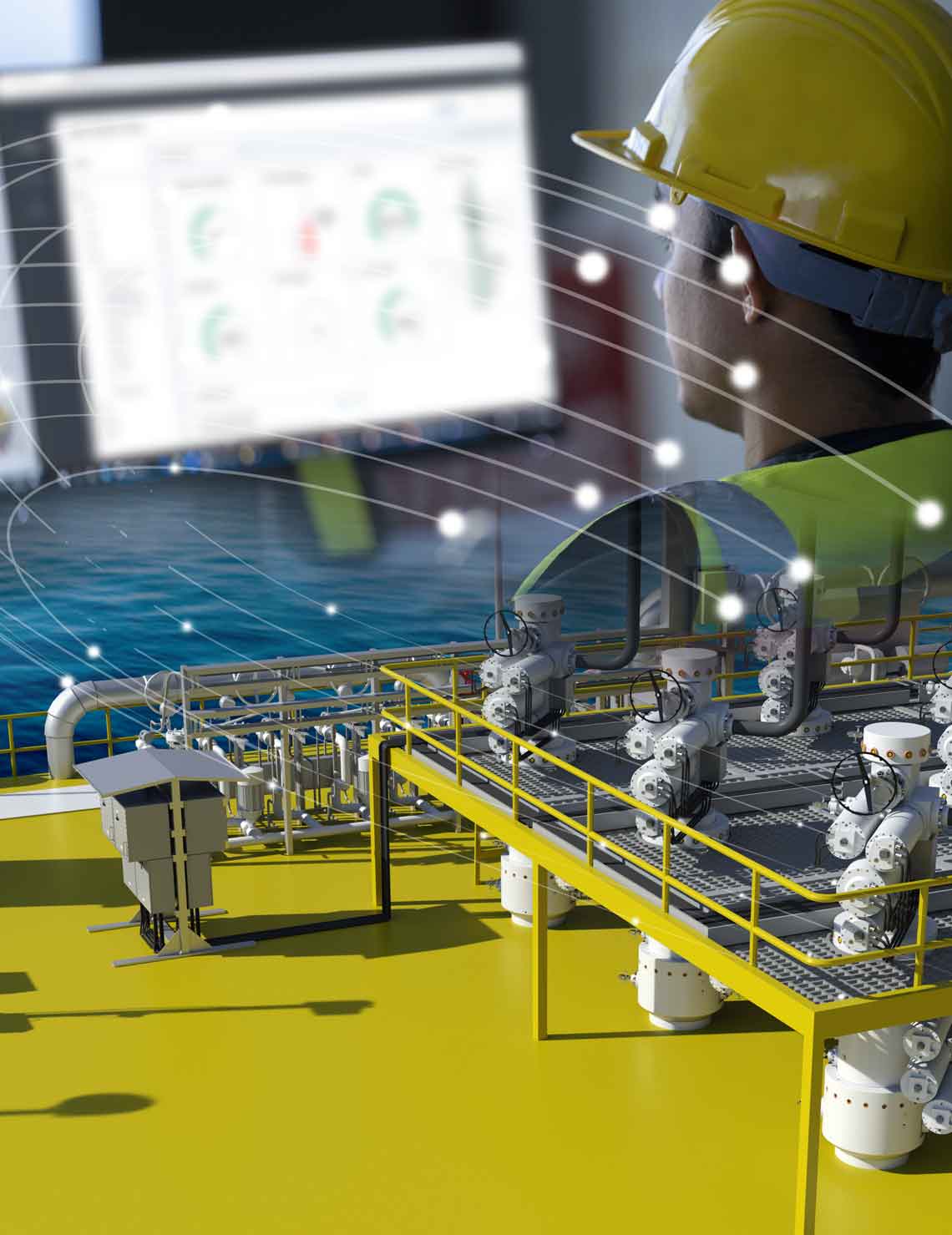Reduce opex, capex, and environmental impact.
All-Electric Surface Actuators: Optimizing Offshore Production Through Electrification
已发表: 02/22/2022

All-Electric Surface Actuators: Optimizing Offshore Production Through Electrification
已发表: 02/22/2022

Following the electrification of wells and subsea production systems, the all-electric surface actuator is the final step toward achieving full production system electrification to improve performance, lower total costs, and support the decarbonization of the oil and gas industry. We sat down with Schlumberger’s Surface Production Systems Digital Product Champion Justin Blair to discuss how replacing hydraulic actuators with all-electric surface actuators can help operators optimize today’s operations and prepare for the future through improved reliability, reduced capex and opex, and greater sustainability.
How are operators currently controlling offshore production?
Operators of offshore surface production platforms have long relied on hydraulic control systems for remote shallow-water operations. This poses a high upfront capex for considerable platform infrastructure to house the systems and accommodate necessary personnel. Hydraulic systems require numerous parts across the supply chain, large spares inventories, and frequent maintenance to ensure they are operating efficiently and without hydraulic fluid leaks. High-frequency maintenance intervals are a significant industry burden because they are supported by transportation events with HSE risks and additional carbon emissions.
The all-electric surface actuator addresses these challenges by enhancing operability through reliability and natural integration into a full electrification and digitalization of the production process, which in turn reduces costs and risks while supporting the decarbonization effort.

What is an all-electric surface actuator and how reliable is it?
Electrification of the surface gate valve actuator and its modular control system brings new reliability and simplicity to remote valve actuation. The digitalization possible with electric control systems provides the means for robust, discrete condition-based monitoring and alarming to significantly reduce operational risk.
Cameron, a Schlumberger company, designed the all-electric surface actuator to meet API Specification 6A. Qualification proved its reliability, executing 400 cycles, equivalent to a 30-year life. The electric actuator is third-party certified to safety integrity level (SIL) 2 standards and its control system, with built-in redundancy, is SIL 3 certified. Cameron is the first in the industry to achieve full Technical Readiness Level 5 (TRL 5) per API RP 17N for the electric actuator and control system, which involved flow loop testing at pressures up to 140 bar and flow rates up to 14.5 MMm3/d.

The failsafe-close spring mechanism in hydraulic systems is also used by the electric actuator to ensure well control in the worst-case scenario of a total loss of power. However, the electric actuator ensures rapid closing during emergency shutdowns. Hydraulic control systems perform inherently slower due to friction losses as the hydraulic fluid that was holding the valve open must escape and vent back to a hydraulic power unit (HPU) through tens of hundreds of feet of hose, tubing, and pipework.
The electric control system minimizes maintenance requirements through its less-complicated design and fewer moving parts. By optimizing opening and closing of the operated gate valves, electric control prolongs their life span and enables grease-free operation.
How can surface electrification help operators today?
Offshore brownfield operators who want to pursue in-field development and continue operations will benefit from going hybrid or all electric. Once installation is complete, the operator will realize long-term opex savings from workforce and transportation reductions resulting from lower overall maintenance, as reflected in a smaller carbon footprint. Electric equipment reliability will bring subsequent expenditure reductions from fewer replacements.
For greenfield platforms, even more savings and benefits can be realized. The smaller size and relative simplicity of electric control systems take up less platform space and slash installation time compared with traditional hydraulic control systems. The latter require pressurized lines—with the potential for released-pressure HSE events—to connect to the HPUs and wellhead control panels. Monitoring the hydraulic controls also poses cabling requirements. The modular and compact Cameron electric control system is easily tailored to the platform and valves. Controls and power are distributed to each well in a ring-type architecture that minimizes cabling installation. Most valve interconnections can be made in advance onshore, saving installation time and expense.
The minimal projected maintenance for electric control systems for the life of the field also introduces consideration of a normally unmanned installation (NUI) with less infrastructure and lower upfront construction capex.

As one of the Schlumberger Transition Technologies, how does the all-electric surface actuator enable more sustainable operations?
As a member of the growing Schlumberger Transition Technologies portfolio of technologies that enable measurable environmental-impact reductions while simultaneously helping customers achieve high performance, sustainably, the all-electric surface actuator was evaluated by applying a science-based methodology that consistently quantifies and proves sustainability impact. The actuator is a key driver for carbon footprint reduction by maximizing infrastructure use, aligning with platform electrification goals, and improving system control.
The all-electric actuator and modular control system avoid up to 66 metric tons of CO2e emissions and save 133.9 MWh per platform per year in comparison with the HPU and wellhead control panel. The CO2e savings are realized by the actuator motor’s lower peak power demand and by a reduction in routine maintenance trips.
What does surface electrification mean for the future of offshore operations?
Electrification of surface production systems reduces maintenance requirements to take the industry one step closer to truly unmanned platforms. Unmanned platform designs will not only cost less and take less time to manufacture but they will also have a knock-on effect for sustainability goals within the industry. Carbon emissions will be reduced across the full supply chain.
Although hydraulic control systems can be outfitted with sensors and instrumentation to provide some level of monitoring, that data is mostly used to infer the root cause of failure. The digitalization achievable with electric control systems advances monitoring to pinpoint where failures are occurring. This robust condition-based capability removes some of the risk from truly unmanned operations.
Today, the industry is ready for all-electric surface production systems and unmanned platforms. Schlumberger has a full suite of technologies and in-house domain knowledge—from subsurface to surface—to help the industry achieve these initiatives.
As operators turn to more sustainable means to extract oil and gas from offshore shallow-water fields, they are realizing that replacement of hydraulic control systems with electrification is the solution. The many components operated by the hydraulic control system on a production platform will ultimately all be electrically operated. The Cameron all-electric surface actuator is necessary for the full electrification and digitalization of offshore surface production platforms to enable operators to produce more continuously, efficiently, and sustainably.

